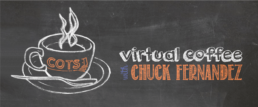Chuck's Virtual Coffee - November 2021
As COTS’ CEO, each month I take a moment to consider what I want our community to know about our organization and our progress in serving Sonoma County’s homeless. I look forward to sharing these thoughts with you in this Virtual Cup of Coffee – my monthly communique about the business and mission moments of COTS (Committee On The Shelterless).
My best,
Chuck
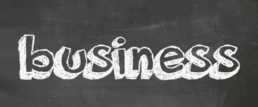
Saying NO is good business
In early November, the City of Santa Rosa issued a request for bids to provide shelter and other homeless services in Santa Rosa. The award would provide $3-4M to the selected operator. COTS did not submit a bid. Why did we pass on this opportunity to potentially expand operations into Santa Rosa and increase our revenues by over 50%? Three words – Focus, Niche, No.
Focus – Many believe that homelessness is primarily a housing problem, and that housing is the foundation for life improvement. The Housing First (HF) philosophy believes that people need a place to live before addressing other critical elements like employment, mental and physical health, and social skills. Thus, HF is based on the principles of quickly connecting people to housing without barriers (lack of income, unemployment, addiction), and then once housed, to provide intense wrap-around case management services to address the issues that led to their homelessness.
Thus, if the primary solution to homelessness is housing and support services, then this is where our focus must be. Operating a shelter and other services in Santa Rosa would completely take us away from that focus. We need to concentrate on what’s in front of us and make a positive impact there – People’s Village (our Tiny Homes Project), the Steamer Landing Injunction and our potential solution to that issue; and Project Homekey and more permanent supportive housing. Submitting a bid would require much strategic planning by staff and the full board and would disrupt our current trajectory. While disruption can be good, chaos is not, and that is what would happen with a bid submittal.
Niche – COTS is a boutique and not a department store. Boutiques focus on excellent customer service, are knowledgeable about their product offerings, pride themselves in being innovative and best in class, and have well trained and professional staff. Customers know what they can expect when they walk into a boutique versus a national department store with an institutional feeling. Boutiques don’t try to be all things to all people. Businesses that do, sacrifice their own boundaries or desires, and have unclear vision and strategies. Sometimes businesses feel pressured to launch a product or service that is outside their strategic goals and competencies. Boutiques, however, specialize.
Our niche is Petaluma and the South Sonoma County area. This is our customer base, and we know the sheltered and unsheltered. We’ve built trust and credibility over the past 32 years. We have no intentions of damaging that trust with those we serve and our valued community. Our brand and messaging would be confusing and inauthentic if we expanded north. And we know that those we serve trust the expertise of a specialized and focused provider who pours all their energy and resources into Petaluma.
No – Saying NO can be the hardest part of business. No is not a dirty word. It’s impossible to pursue every opportunity. Steven Jobs (the Apple guy) once said, “People think focus means saying yes to the thing you’ve got to focus on. But that’s not what it means at all. It means saying no to the hundred other good ideas that there are. You have to pick carefully. I’m actually as proud of the things we haven’t done as the things I have done. Innovation is saying no to 1,000 things.”
To execute well, a business must be crystal clear on its vision, strategy, and goals. And that means staying true to your vision.
Thus, before one says no to opportunities, one needs to first say yes to their vision and strategy. That will keep you from diverting your precious time, energy, and resources and take you from being just good to being truly great.

Being Grateful
Petaluma is embarking on three major projects to house those experiencing homelessness – People’s Village (Tiny Homes); the Steamer Landing Injunction process, and Governor Newsom’s Project Homekey to purchase hotels for permanent supportive housing. These three initiatives require significant collaboration and constant communication to make it happen.
I am so grateful for our Petaluma partners without which none of this would happen. The City of Petaluma Team of City Manager Peggy Flynn, Assistant City Manager Brian Cochran, Housing Manager Karen Shimizu, and the rest of their team are boldly and fearlessly leading the way. Our Petaluma Police Department and their team of excellent, caring, and responsive officers. Annie Nicol, FNP, PA, Director of Homeless Services for the Petaluma Health Center. Annie has been doing this work for decades and knows every person experiencing homelessness in Petaluma and has a heart of gold. The SAFE Team (Specialized Assistance for Everyone) and Downtown Streets Team who are everywhere in Petaluma assisting the homeless with care, patience, and love. Homeless consultant Andrew Hening, whose expertise, experience, and strategic vision keep us on track and make our team even stronger. And of course, our community whose generosity, patience, and understanding make much of this happen.
In the spirit of Thanksgiving, thank you everyone for all of your support and leadership. We are making progress.

Until next month,

Chuck Fernandez
Chuck's Virtual Coffee - October 2021
As COTS’ CEO, each month I take a moment to consider what I want our community to know about our organization and our progress in serving Sonoma County’s homeless. I look forward to sharing these thoughts with you in this Virtual Cup of Coffee – my monthly communique about the business and mission moments of COTS (Committee On The Shelterless).
My best,
Chuck
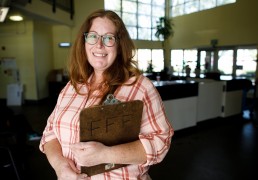
Homelessness and Social Innovation
Homelessness is an extreme form of poverty and human deprivation. It’s now the most visible and major problem that many cities face, especially in California. There is a growing gap between the scale of the problem and the solutions we offer. Just visit San Francisco, Los Angeles, or even some of our cities in Sonoma County.
Social Innovation or SI is about applying solutions to social or environmental problems to address unmet needs and improve people’s lives. It’s not a new concept and doesn’t require inventing new products or services. It can apply an existing product or service in a new context. SI however must address the problem better than the existing alternatives.
We can think of SI as a four-step process – identify a new or unmet social need; develop a new solution to the need; evaluate the effectiveness of the solution; and then if the SI is successful, scale up the innovation. The last step is called Social Entrepreneurship, where we apply business practices to scale up the innovation for greater positive impact.
The reason I talk about Social Innovation is that I’m encouraged by what I am seeing in Sonoma County from our homeless services partners and their willingness to innovate to address homelessness. For example, Tiny Homes are not new. They’ve been around since the 1970s. It’s just of late that cities started using Tiny Homes to address their growing homeless population exacerbated by the lack of affordable housing, cost of living, and the impact of COVID. Now, there are several Tiny Homes projects in Sonoma County and more on the way.
Our Continuum of Care team is talking about an Open HMIS (Homeless Management Information System) where we share client information between homeless providers in the County. As the unsheltered utilize the same shelters and providers, having an Open database system with updated client information prevents the client from retelling their story again and again and thus being retraumatized. It also makes for a more efficient process as the next provider can pick up the case management process from the last provider. It’s like a person’s medical record being available to all their medical providers. An open database system or software system is not a new concept – just think of Linux and their open-source process. We are just using the concept to provide better, more efficient services for those experiencing homelessness.
And we are also talking about a Centralized Housing Locator function staffed by housing professionals that know the rental market. Instead of homeless providers each hiring their own Housing Locator and competing to find housing for the unsheltered, a centralized process is cheaper and more efficient. It’s also a common business practice.
No too long ago, the thought of any of the above was unthinkable. But because of the growing gap between the scale of the problem and solutions, we need to work differently. One benefit of Social Innovation is that more collaboration and social relationships are being created. We’re trusting each other and communicating more. And we’re sharing our plans and our mistakes made so that the next person who tries a tiny homes village doesn’t make the same mistakes. We are making progress.
One more Social Innovation I’d like to implement in Sonoma County is an “Innovation Fund.” There are people, organizations, and start-ups with ideas, they just need seed funding to start. I can think of some in Santa Rosa (SAVS), Sonoma Valley (Homeless Action), and Petaluma. They are a scrappy bunch that are persistent, bold, daring, undeterred, and fiercely passionate about their ideas and mission. Doesn’t sound too different from some in Silicon Valley. So why not set aside funding every year to try new ideas. And so what if they fail. You just step back, reassess, try again, and perhaps fail again. Ultimately with the right support and guidance, some will hopefully succeed. The truth is that many start-up businesses fail. Social innovation or social entrepreneurships are no different. However, one thing is for sure – they all have the starting point of empathy and concern for the homeless and to treat them with dignity and respect. I think that is worth investing in.

Until next month,

Chuck Fernandez
Chuck's Virtual Coffee - September 2021
As COTS’ CEO, each month I take a moment to consider what I want our community to know about our organization and our progress in serving Sonoma County’s homeless. I look forward to sharing these thoughts with you in this Virtual Cup of Coffee – my monthly communique about the business and mission moments of COTS (Committee On The Shelterless).
My best,
Chuck

The Excitement of Back to School…Maybe
It’s Fall and that means lots of news about students going back to school, excited to see their friends and teachers, parents relieved of no more online learning, and stadiums filled with football fans. And because we live in unprecedented times, there are also the many challenges with COVID and keeping students, teachers, and everyone else safe. But what I’ve not seen in the news is the hidden reality of students who are homeless. How extensive is student homelessness, what’s the impact of homelessness on students and their ability to learn, and what can we do about it?
There’s lots of data from the National Center for Homeless Education, The Learning Policy Institute, and the National #Real College Survey Report. So let me share some numbers. And unfortunately, these numbers are pre-pandemic. Likely, things have worsened for homeless students.
- In California, there were 271,520 homeless youth enrolled in public schools in grades Pre-K through 12 in 2018-19. Of that, 30% were students with Limited English Proficiency; 83% were doubled up living with another family; 7% were living in shelters; 5% were living in hotels; and 4% were unsheltered living in cars, parks, campgrounds, or abandoned buildings. 70% of the homeless students were Latino and 9% were Black.
- Nationally, there were 1,384,301 homeless youth enrolled in public schools in grades Pre-K through 12 in 2018-19. Of that, 16% were students with Limited English Proficiency; 77% were doubled up living with another family; 12% were living in shelters; 7% were living in hotels; and 4% were unsheltered living in cars, parks, campgrounds, or abandoned buildings.
- Among 86,000 college students surveyed at 123 two and four year colleges in 2018, 17% experienced homelessness in the previous year; 45% were food insecure in the prior 30 days; and 56% were housing insecure in the previous year.
- In Canada, 63% of youth experiencing homelessness did not complete high school. We know that youth who do not graduate high school are 4.5 times more likely to face homelessness than their peers who graduated.
- The relationship between education and homelessness is “bi-directional – low education attainment increases the likelihood of homelessness and homelessness reduces the likelihood of school completion.” It’s a no-win situation.
So what’s the impact on students when they are homeless? Having a roof over your head, a safe place to sleep, and healthy food in your stomach is absolutely essential to just about everything. Chronic absence from school was 25% for homeless students compared to 12% for non-homeless students. Absences were higher for students of color. Homeless students are more likely to change schools multiple times throughout the year and also be suspended more. Homeless students are also more likely to enroll in high-poverty schools or where the percent of students eligible for free or reduced meals was greater than 80%.
Homeless students are also less likely to meet state achievement standards in Math, Reading, and Science. Many of these students have learning disabilities; experience stress, trauma, and depression; and suffer from poor physical health. The pressures of school and learning are hard enough for normal students. Now imagine trying to focus and learn under all of the stressors of being homeless. Moreover, students often need a guardians signature to participate in school activities. But what if you are unaccompanied and living alone in a car or on someone’s couch?
The contributing factors driving student homelessness are many. There is the ever increasing cost of housing; the lack of affordable housing; increased usage of opioids and methamphetamines; persistent poverty; underemployment and unemployment; more gentrification in neighborhoods; and the increasing natural disasters due to climate change – hurricanes on the Gulf Coast and wildfires in the West.
And the answer to student homelessness? I don’t know. The government is providing funding for this problem. Schools are aware and doing everything they can under the circumstances. At COTS, we are examining our Kids First and Family Shelter (KFFS) programs and services. We know we have to change the way we operate. We cannot foster generational poverty and homelessness.
One thing we do know, and that is every human being has the capacity to develop resiliency and persevere in the face of adversity. They just need someone who believes in them, guides them, and has unconditional love for them…like a grandparent, aunt or uncle, a teacher, or a coach. We hear about success stories all the time. Our job at COTS is to support policies, practices, and environments that help foster this resilience and provide unwavering support and unconditional love. With that and a bunch of luck, everything is possible.
References used:
http://profiles.nche.seiservices.com/StateProfile.aspx?StateID=6
https://learningpolicyinstitute.org/product/students-experiencing-homelessness-report
https://hope4college.com/wp-content/uploads/2019/04/HOPE_realcollege_National_report_digital.pdf

Until next month,

Chuck Fernandez
Chuck's Virtual Coffee - August 2021
As COTS’ CEO, each month I take a moment to consider what I want our community to know about our organization and our progress in serving Sonoma County’s homeless. I look forward to sharing these thoughts with you in this Virtual Cup of Coffee – my monthly communique about the business and mission moments of COTS (Committee On The Shelterless).
My best,
Chuck

Tiny Homes – A Big Solution
Tiny Homes have been around for a long time. Some define it as a house less than 400 square feet. Many are much smaller – 100 square feet or less. They come in lots of bright colors, styles, shapes, and building materials. Some even have wheels on them. But one thing is for certain – people have lots of opinions about Tiny Homes.
For some who embrace the Tiny Homes lifestyle, it represents a shift in their values – a preference for simplicity; freedom from the many responsibilities of living in and the maintenance required of a large home; environmental consciousness; self-sufficiency; and even saving money. For them, less is more.
But for those experiencing homelessness who have very little, a Tiny Home is about having more – a sense of privacy and security where one can lock their door at night; a sense of dignity, pride, and empowerment of having a place to call home; getting a good night’s sleep without the fear of being beaten or awakened to evacuate the campsite; a place to store their belongings; and a place to be with their loved one and pets. In a Tiny Home or Tiny Homes Village, there are also shared hygiene facilities – bathrooms, showers, washers and dryers, clean water – the human basics we all take for granted. There can also be a community kitchen with refrigerators, cooktops, microwaves or even a meal delivery service.
As COVID is not going away anytime soon, Tiny Homes are even more important for those experiencing homelessness. The mandate from public health and the CDC to shelter in place, social distance, and to maintain proper hygiene is not possible if you don’t have a home. A fundamental necessity of homelessness is the constant search for food, bathrooms, warmth, water, and shelter. That means interacting with others or being in public places. The homeless are often elderly or in poor health, which are two significant risk factors for COVID.
Congregate shelters have been forced to reduce their bed capacity to accommodate social distancing. That means there are fewer people in shelters and thus more on the streets. My guess is that after COVID, it’s unlikely that public health will allow shelters to return to their normal practice of allowing residents to sleep in close proximity. So where are those folks to go? Back on the streets, public parks, and on private property. And as I mentioned in my May Virtual Coffee on Environmental Justice (https://cots.org/2021/06/chucks-virtual-coffee-may-2021/), the damage that the unsheltered cause to the environment is significant.
So are Tiny Homes the solution to homelessness? They are one temporary, necessary, and big step in addressing our homeless crisis. They are inexpensive and quick to build. And they are part of broader and longer-term strategy to address homelessness that includes building more permanent and affordable housing; having more housing vouchers that allow individuals and families to live in market-rate places; and providing intense wrap-around case management services that includes mental health and substance abuse counseling that help residents stabilize and stay in their home.
Tiny Homes are also where the transformation can begin where residents transition into more permanent housing. Given their empowerment, sense of pride and dignity, and access to many services to help them return to health and wellness, don’t be surprised if the residents in Tiny Homes achieve more success than those in traditional congregate shelters to get permanent housing. It’s where the magic can happen.
And one more very important thing. Housing is a human right – especially if its temporary, tiny, and for people experiencing homelessness.

Progress with our Homeless System of Care
Integrity is about having a sense of what is right and wrong; about using moral and ethical principles in every decision and action; and about doing the right thing, even when no one is watching. Attributes of integrity include empathy, honesty, humility, accountability, and humanity.
I am a member of the Continuum of Care (CoC) Board of Directors. We are charged with overseeing, allocating financial resources, creating a strategy, and working together with other homeless service providers in Sonoma County to end homelessness. We work closely with various County Departments and the Community Development Commission (CDC) on all things homelessness. This is a very big task and one I thought had little chance of success.
But I’ve recently changed my mind…in a good way. Why – because my colleagues on the CoC Board, County Departments, and the CDC all act with integrity. They care, are passionate and committed to ending homelessness, smart, have a sense of urgency, are realistic but not afraid to think big and bold, they hold themselves and each other accountable for results, and are inclusive and respectful of those experiencing homelessness. We have a long way to go – creating a County-wide strategic plan; improving how we communicate with and better inform the public about homelessness; improve our data systems to better track our performance; being willing to try more innovative solutions to homelessness…like Tiny Homes or safe parking; build more affordable homes and access more housing vouchers; and get access to many more financial resources.
But it takes time and patience to do a difficult and important job. And we will get this right. Thank you for hanging in there with us. We will get there.

Until next month,

Chuck Fernandez
Chuck's Virtual Coffee - July 2021
As COTS’ CEO, each month I take a moment to consider what I want our community to know about our organization and our progress in serving Sonoma County’s homeless. I look forward to sharing these thoughts with you in this Virtual Cup of Coffee – my monthly communique about the business and mission moments of COTS (Committee On The Shelterless).
My best,
Chuck

Data Conundrum
Nonprofits face lots of data conundrums. They must show program impact and deliverables to private donors, foundations, and government agencies that financially support them. Boards of Directors want data as part of their governance responsibility. And Accounting, Human Resources, Fundraising, Grants, and Programs need data to monitor their performance. The result is that different stakeholders want different data to make different decisions. And collecting the data can be cumbersome, confusing, or based on complicated formulas. Doing this every month becomes an onerous and dreaded chore that no one looks forward to – a burden. And what often happens is data drift, where we can’t decide what to measure or what’s important, so we try and measure everything. And that is a waste of time and staff resources.
But we need the right data for several reasons – to understand if our current programs and activities are achieving their intended results; to drive improvement; to communicate a common understanding and language to various stakeholders on what we intend to achieve and how we’ll do that; to advocate for more community support; and of course, to accomplish our goals. Good, accurate, and timely data should reveal what happened (descriptive); why it happened (diagnostic); what will happen next (predictive); and inform the user what they should do about the results (prescriptive). The data should also be easy and simple to get.
As businesses change, grow, and mature, so too must their data needs and what to measure. Homelessness has changed over the years and the data we collect, analyze, and make decisions from also need to change. The Housing First model has resulted in a very different population served at COTS. We see the most difficult clients – those with severe and persistent mental health issues, physical disabilities, substance abuse challenges, and social and behavioral issues. As much as we offer services to help improve their situation, many simply have no interest. The Housing First model calls for removal of barriers to shelter entry and then to provide services without any mandates to accept them. While housing is the solution to homelessness and will always be our hope, it may not be their hope and thus it is not realistic to believe that many will get housed. With the high cost of living, limited affordable housing, and low income of many of our clients, housing is not always a realistic goal. Often, success for COTS is getting someone off the streets, into a shelter with a warm bed, hot food, and laundry and shower facilities with the hope of restoring some dignity and comfort in their lives…even for a short time. While the hoped-for destination is housing, the journey is just as important if not more so for those not wanting help or housing but just some interim relief from the chaos of being unsheltered.
Therefore, data such as cost per person housed; number of households diverted from homelessness; length of stay in the shelter; or number of people participating in our programs is no longer practical, useful, or relevant.
Iain De Jong, in his book, The Book on Ending Homelessness, says “the three metrics that matter most to homeless service providers are: (1) How many people are homeless? (2) How many people moved into permanent housing? (3) How many people fell back into homelessness after being housed? If one captures these three metrics remarkably well, then the industry would move forward leaps and bounds.”
That’s a good start and as it relates to the Program and Services COTS offers to those experiencing homelessness, I would add one more – the breakdown by race/ethnicity of those we serve. It’s critical that we also address systemic race issues within our homeless system of care. It’s the right thing to do.
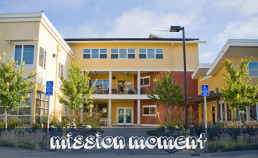
Delta Variant
Just when we thought COVID was on the decline in Sonoma County, here comes the delta variant and a surge in positive cases. But thanks to Human Resources Director Cat Higgins and Shelter Services Manager Robin Phoenix and her team, COTS never let their guard down. Cat and Robin insisted on following CDC and Sonoma County Public Health guidelines for safety, sanitation, testing, isolating, and masking in a congregate living shelter.
The results have been simply amazing. As of this writing, only two positive cases at COTS and the Mary Isaak Center – one shelter resident that had a vaccine and another shelter resident who did not show any symptoms. One of those cases was transported to the Alternative Care Site (ACS) and we are still waiting for the test results from the other case.
All shelter residents are required to show proof of vaccination or have a negative test result within 72 hours of coming into the shelter. Robin also re-instituted the “red zone” which is a quarantined area for people awaiting test results. Also, Public Health was at the Mary Isaak Center last week testing every resident for COVID and also providing vaccinations. Only one resident refused to get tested and was exited from the shelter. And so far, all the test results of the residents were negative.
Moreover, Robin communicates with Sonoma County Public Health, Petaluma Health Center, and Petaluma’s Police Department, City Manager’s Office, and the new SAFE (Specialized Assistance For Everyone) Team about our safety protocols and any new infections. It’s important that we communicate with our partners.
Cat, Robin, and her team deserve major thanks, kudos, and appreciation for keeping staff and shelter residents safe. It’s not been easy, comfortable, or convenient. But it’s difficult to argue with the results. Thank you, Cat, Robin, and team for leading the way.

Until next month,

Chuck Fernandez
Chuck's Virtual Coffee - June 2021
As COTS’ CEO, each month I take a moment to consider what I want our community to know about our organization and our progress in serving Sonoma County’s homeless. I look forward to sharing these thoughts with you in this Virtual Cup of Coffee – my monthly communique about the business and mission moments of COTS (Committee On The Shelterless).
My best,
Chuck
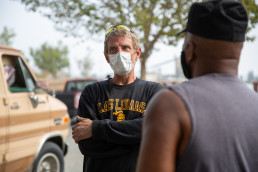
Climate Change and Homelessness
The City of Petaluma’s Climate Action Commission was established in 2019 to address and elevate climate issues to the City’s highest priority. Climate change and mitigation is at the center of the City’s goal setting, creation of policies and procedures, and allocation of resources. With drought, soaring temperatures, and seasonal fires, climate change is real and the Commission is the right thing to do.
In its inspiring document, Climate Emergency Framework, one of the Commission’s Values is the creation of Social and Ecosystem Resilience Together. That means a holistic thinking that aligns sustainable economies with thriving ecologies including a reduction of pollutants and toxins, restoration of ecosystems, improvement in public health, community cohesion, and well-being. The Framework acknowledges that “frontline and marginalized communities are already disproportionately negatively affected by climate change.” The disproportionately affected include those experiencing homelessness.
So what is COTS doing to create Social and Ecosystem Resilience Together? Lots. But first, let me share some numbers as context.
At the Mary Isaak Center, we: have 80 regular shelter beds; 6 beds for homeless patients who are discharged from the hospital and need a place to recover; 12 beds in our supportive housing program; serve 4,500 meals per month on average; work with up to 110 volunteers per month as we come out of COVID; and have 45 employees. This is a lot of human activity that uses considerable energy and water.
At the Mary Isaak Center, we: replaced all lights with energy efficient LED lights; are investing $30,000 in new Energy Star Certified washers and dryers that use 25% less energy and 33% less water; installed touch-less water faucets in all bathrooms, low-flow water faucets in the kitchen, and low-flow shower heads in the showers; replaced the kitchen dishwasher with a steamer that uses 75% less water; reduced our total water usage from a high of 19,387 cubic feet per month in 2019 to 11,376 cubic feet per month in 2021 for a 41% reduction; replaced our gas powered leaf blower and lawn mowers with battery-powered units; partner with Protein Products in Petaluma to take all food waste/scraps to create protein products for animals; and recycle all cardboard, plastics, cans, and glass.
We are also having active conversation about a COTS campus expansion that could include safe parking, sanctioned encampments, even tiny homes. As mentioned in my May Virtual Coffee about environmental justice, we know the damage that encampments can do to the natural habitats and ecosystems. We believe that moving the unsheltered to a safe and dignified area where they also have access to clean water, sanitation, bathrooms and showers, laundry facilities, and get access to much needed medical and social services could provide for a safe and dignified life. We want to be good stewards of our environment, improve our ecological health, be an example for climate mitigation for other shelters, while also caring for the unsheltered with all the dignity, respect, and safety they deserve.
Petaluma Climate Action Commissioner Ned Orrett said, “the earth is a marvelously interconnected living system.” The Framework also said that “climate equity and environmental justice help heal systemic social injustices and ensures all community groups have the resources to use non-polluting energy systems and live in environmentally healthy communities.” Our goal at COTS is to maximize opportunities for all unsheltered and sheltered people to live in clean and healthy environments that protect against the impacts of climate change and environmental pollutants. It is the right thing to do.

Until next month,

Chuck Fernandez
Chuck's Virtual Coffee - May 2021
As COTS’ CEO, each month I take a moment to consider what I want our community to know about our organization and our progress in serving Sonoma County’s homeless. I look forward to sharing these thoughts with you in this Virtual Cup of Coffee – my monthly communique about the business and mission moments of COTS (Committee On The Shelterless).
My best,
Chuck
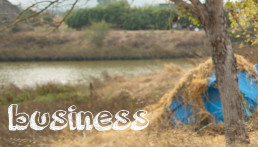
Environmental Justice
Articles in the newspaper about homelessness usually focus on encampment sweeps, reasons a person becomes homeless, types of health challenges faced, or the need for more affordable housing. What’s not often covered are the impacts of encampments on the environment or the effects of climate change and pollution on the homeless. Basic human rights like clean water, sanitation, bathrooms, and a safe place to live – the things many of us take for granted – are also not covered. The convergence of all these challenges makes solving homelessness one of our biggest issues today.
The unsheltered live, eat, sleep, socialize, and take care of basic human functions all outdoors. Human waste contaminates the ground and water. There are large amounts of trash and contaminated needles. Fires also occur in camps and given the drought conditions of Northern California, could be devastating. Encampments cause significant damage to parks, habitat, riparian areas, and connected waterways. But let’s be fair. The unsheltered may not understand proper camping protocols. And in my experience, it is not their intent to harm the environment. They would rather be somewhere safe and with access to services that can help them. And for many legitimate reasons, living in a congregate setting like a shelter does not work for everyone.
Climate change and pollution also directly impact the unsheltered. Some sleep near roads or under bridges exposing them to high levels of auto related emissions. As temperatures increase, more are susceptible to heat stress.
Compromise
Many of us fight for social justice and equity. But what about environmental justice, where we try and balance the need to keep our environment safe and healthy while also providing a safe and dignified living environment for the unsheltered. How do we create a better situation for the unsheltered and the environment?
One answer is compromise. What if we utilized a large plot of land where the unsheltered can live temporarily without fear of being roused to move on? There would be space for tents, vehicles, even tiny homes. And what if services were provided to help address challenges like mental health, medical, substance abuse, and case management services to assist with life skills and to find housing? The ultimate goal is to get people stabilized and then into a type of housing that works for them. Some may not want a traditional apartment or house to share with others. Maybe a tiny home structure to call their own is all they want. While the unsheltered may not have the freedom to do whatever they please, neither does anyone else. The win-win is that they are in a safe place with clean water, access to showers and laundry, hot meals, and services to assist them back to health. We also minimize harm to the environment while allowing others to enjoy the beauty and safety of parks and public areas.
As we continue to address the complexities of homelessness, let’s not forget one basic premise – we are all human beings and deserve respect. Respect means to accept someone for who they are even when they are different from you or you don’t agree with them, their living style, or their situation. It means not passing judgement just because someone is without a home. Homelessness does not define a person. It only defines their situation. That is why we say a person experiences homelessness. We hope that it is a temporary living situation. We are all equal and all people are due respect for the simple fact that they are people…including those experiencing homelessness.

Until next month,

Chuck Fernandez
Bringing Mindfulness to the Mary Isaak Center

Shelter Case Manager Chris Inclan knows firsthand the power of having the right tools in your proverbial tool belt. “I come from not a great household,” he says. “My mom was an addict and my dad was an alcoholic, my dad left when I was really young, and I kinda raised myself in a way.” He got into a lot of trouble growing up, spending time in and out of jail, and struggled with addiction himself until he hit a spiritual bottom. “I was basically lost and felt empty inside,” he says, “and I got on my knees and I asked for help from whatever was out there in the universe, and it guided me to the rooms of Alcoholics Anonymous.”
After entering recovery, Chris went back to school and became a substance use disorder counselor. “I was going to go to school for business,” he says, “and I thought, what’s better than helping people with their addiction?” He worked as a substance use disorder counselor for four years before joining COTS six months ago, where his lived experience makes him uniquely qualified to lead the meditation and self-esteem group for Mary Isaak Center residents every Saturday.
He designed the group to help all COTS clients who might need it, not just those struggling with addiction. He got the idea from a self-esteem group they ran at his previous job, and decided to add in the components of meditation and mindfulness to round it out. “I remember the group being really beneficial and getting a lot of good feedback from clients in treatment. So I thought, let’s put a group together that can help with addiction issues but can also help anybody that’s just trying to better themselves.”
Every meeting starts with a check-in, a reflection period to see how everyone is doing, followed by a meditation. “Most of the time it’s a guided meditation,” says Chris, but depending on the people present, it can get a little more creative, like a chanting meditation. Then the group finishes with an exercise from a self-esteem packet, or something else Chris feels is important, like emotional intelligence.
“I’m trying to give our clients new tools, a new way to look at the world,” Chris says. “A lot of our clients have an external locus of control, and when we live from a place like that, it’s not empowering, because you don’t feel like you have any control in your life. I wanted to bring in the self-esteem component so our clients can start moving towards an internal locus of control, so they can start recognizing that they have choices. When you start choosing better decisions for your life, you’re going to feel better, you’re going to do things that will move you forward, instead of doing things that will set you back. It’s not a perfect science, but if you really give yourself to this process and make this a way of life, then I think the outcomes are totally different than if you’re just living on autopilot.”
Right now, the group is small, “but we’re trying to grow it,” says Chris. “Even if it only helps a couple of people,” it’s still worth it.
“For the person that does want help,” he adds, “being able to have the right things in place, the proper tools and assistance, [is key]. COTS does a good job of that. The culture here and the environment is really conducive to growth and getting better. This is the right place to come if you really want to change because we’re going to be able to plug you in and connect you with the right people. We’re using what we have to make a difference.”
Planting Seeds: New Mental Health Offering at COTS
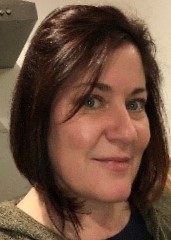
At COTS, we are always looking for innovative ways to better serve and support our clients, not just in finding housing, but in maintaining it. That’s why starting this Spring, we are excited to add a new mental health offering for Integrity Housing clients, in partnership with Licensed Marriage and Family Therapist Karyn Duffy.
Thanks to the support of two very generous supporters, Karyn will be able to provide three 50-minute therapy sessions a week to clients living in Integrity Housing, at absolutely no cost to our clients.
Currently, Integrity Housing serves about 60 clients in 11 houses. In order to serve the most people, Karyn will be using a short-term solution-oriented strategy, working with each client for a maximum of twelve weeks. “There are just too many people in that program to only provide three people with ongoing services,” Karyn says. “We’re going to check in on a regular basis, chart out accomplishable goals, and then show a positive outcome. To me, twelve weeks feels very doable.”
A unique challenge Integrity Housing poses is shared living. Each house has a mix of individuals and families living in it, having been referred from a mix of COTS’ emergency shelters and other partner organizations. They have never met prior to living together, and they typically move in without seeing the house first. “We do the best we can to make appropriate referrals for these houses,” says Jules Pelican, Director of Programs, “but residents do not have the ability to choose who they are going to live with.”
Add to this that many COTS clients have experienced Adverse Childhood Experiences (ACEs), which contribute to mental health challenges, and can make living communally more difficult. “This is one of a hundred reasons that therapy is important to our clients,” says Debbie Robbins, who oversees the Integrity Housing program.
Karyn is a long-time COTS partner, which makes her the perfect person for this new partnership. “This will be my tenth year,” she says. Originally an intern through Petaluma People Services Center, over the years Karyn has offered support to both COTS clients and staff, performing in-home visits, facilitating support groups, and offering private therapy sessions. “She’s done a lot for us,” says Jules. “She works in both of our Permanent Supportive Housing programs, she offers sliding scale sessions for folks who used to be COTS clients so that they can keep seeing her – some people have seen her for years.”
Part of the beauty of Karyn’s long-standing partnership with COTS, says Debbie, “is that because she knows COTS so well, when our clients go to her, or staff for that matter, they don’t have to waste a session or two explaining about COTS culture, and that’s a time saver for everybody.”
“Jules always said I know how to be with people,” says Karyn. “I actually am really humbled by my work with COTS. When you look at the tenacity of people and their sense of survival, and their will power, it just blows me away. They’re surviving, they’re strong, and they want to be better. Broken people are not just to be discarded; they need compassion and respect and understanding.”
With this new offering, Karyn will be able to help even more people. “If we had good county mental health services to serve our folks,” says Jules, “we wouldn’t have to go out and pay for our own therapist. But because we don’t have adequate mental health supports in the county, this has been a beautiful workaround.” Adds Debbie: “To have these funders realize the importance of having somebody available for our clients to discuss any issues…it’s a game changer for some of our folks. This is huge.”
Your support is what allows us to keep valuable offerings like this as we continue to explore new ways to support those whom we serve. Thank you for investing in COTS and our community!
Chuck's Virtual Coffee - April 2021
As COTS’ CEO, each month I take a moment to consider what I want our community to know about our organization and our progress in serving Sonoma County’s homeless. I look forward to sharing these thoughts with you in this Virtual Cup of Coffee – my monthly communique about the business and mission moments of COTS (Committee On The Shelterless).
My best,
Chuck

Shopping Carts – Not Just for Groceries
A sight that always makes my heart sad is to see a person experiencing homelessness pushing a shopping cart. There is no human dignity in that. For many, a shopping cart is what we use at the store for things we buy. But for those without a home, a cart “acts as kind of a life raft.”
The most common use of that “life raft” is the most obvious – to carry their possessions. I see carts around the Mary Isaak Center with stuff that makes no sense to me – cans, a broom, frisbee, BBQ grill, tires. But those things may have a sentimental value – a reminder of better times when they had a home. Or they may be insurance for the future – things they may need or could sell. Perhaps it’s because they’ve lost so much in their lives – their job, home, family, friends and children, that they gather things just to hold onto something. The carts also carry blankets, cardboard, sleeping bags, tarps and things they need at night to survive, and to stay warm and dry.
What’s not so obvious is that they also use the carts for protection and safety at night. Flipping it on its side or back to use as shelter to protect themselves from people who want to steal from or harm them. It’s an unfortunate reality for those without a home. Carts are also used to carry their pets. What would you do if you lost your home or were evicted from your apartment and had pets? Pets are like family to many of us, including those without a home, so you take them with you. And because those without a home walk much of the day, the carts help provide rest for the pets. Carts are also used to collect cans, bottles, and other items to sell at redemption centers.
And sadly, carts can also be used as a type of walker. Many unsheltered have physical disabilities that make walking difficult. And because libraries and other public facilities were closed during the pandemic, there were fewer places for the unsheltered to go to, sit down, take refuge, and rest. It’s one thing to push a cart in a store with smooth flooring or a paved parking lot but try pushing a cart on bumpy uneven surfaces. It’s hard and tiring.
Taking a shopping cart from a retailer is theft. Replacing carts is expensive. But many retailers don’t press charges against people without financial means. There is also a compassionate side with retailers, law enforcement, and others that respond to complaints about the homeless and shopping carts. I know that because I witness it daily at the Mary Isaak Center by our wonderful and loving Petaluma community – our own retailers and businesses, Police, Fire, EMT, Medical community, and so many others. They have big and warm hearts and don’t want to make a difficult situation worse.
I don’t know what the answer is with shopping carts. But maybe one solution to not seeing shopping carts by those without a home is simple – kind of – let’s get everyone in a home or a warm and safe living environment that works for them.
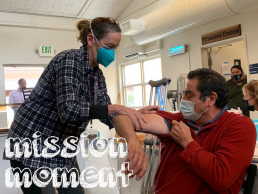
A shot in the arm…
This month, COTS had its first COVID vaccine clinic. We had 80 doses to give, and we used all 80…for the sheltered and unsheltered, some COTS staff, community volunteers, and the general public. This was the single dose Johnson and Johnson vaccine. This clinic was in large part due to the heroic volunteer efforts led by Dr. Loie Sauer MD, Annie Nichol FNP from the Petaluma Health Center, the Sonoma County Medical Association, Fox Home Health Care, and a team of nurses, a dentist, retired physicians, and so many more.
Our plan was to vaccinate many of our sheltered and unsheltered. We did some, but not as many as we’d hoped. They have the same questions, concerns, and hesitations as the general public. Trust is paramount and they do not trust the medical community or anyone in authority telling them what to do. Their daily struggle to survive, find food, water, and safety overrides most everything else, including a “little virus” that just doesn’t seem as critical as the other stuff they face. Some have mental health issues like paranoia that prevent them from trusting the vaccine.
Like others, conspiracy theories also prevent the unsheltered from getting a vaccine. “They put a special dye in it and it’s like small robots going into your system that helps change your DNA…” or “they are putting a chip in you and you are going to be someone’s guinea pig…” or “the disease is caused by 5G cell towers…”
Of course, it’s difficult for anyone living outside, whose health is already compromised, to follow public health recommendations – social distancing, hygiene, staying at home when you have no home, or seeing your doctor. The unsheltered also lack internet access to sign up with online vaccine portals, lack transportation to vaccination sites, or don’t have the right information about vaccines.
The 2020 annual Point in Time Count showed 2,745 sheltered and unsheltered in Sonoma County. That was pre-COVID and I am certain that number has increased. We have a long way to go to get everyone vaccinated. But this was a good start. Thank you everyone who made this pop-up clinic happen. We are grateful and appreciate you.

Until next month,

Chuck Fernandez
